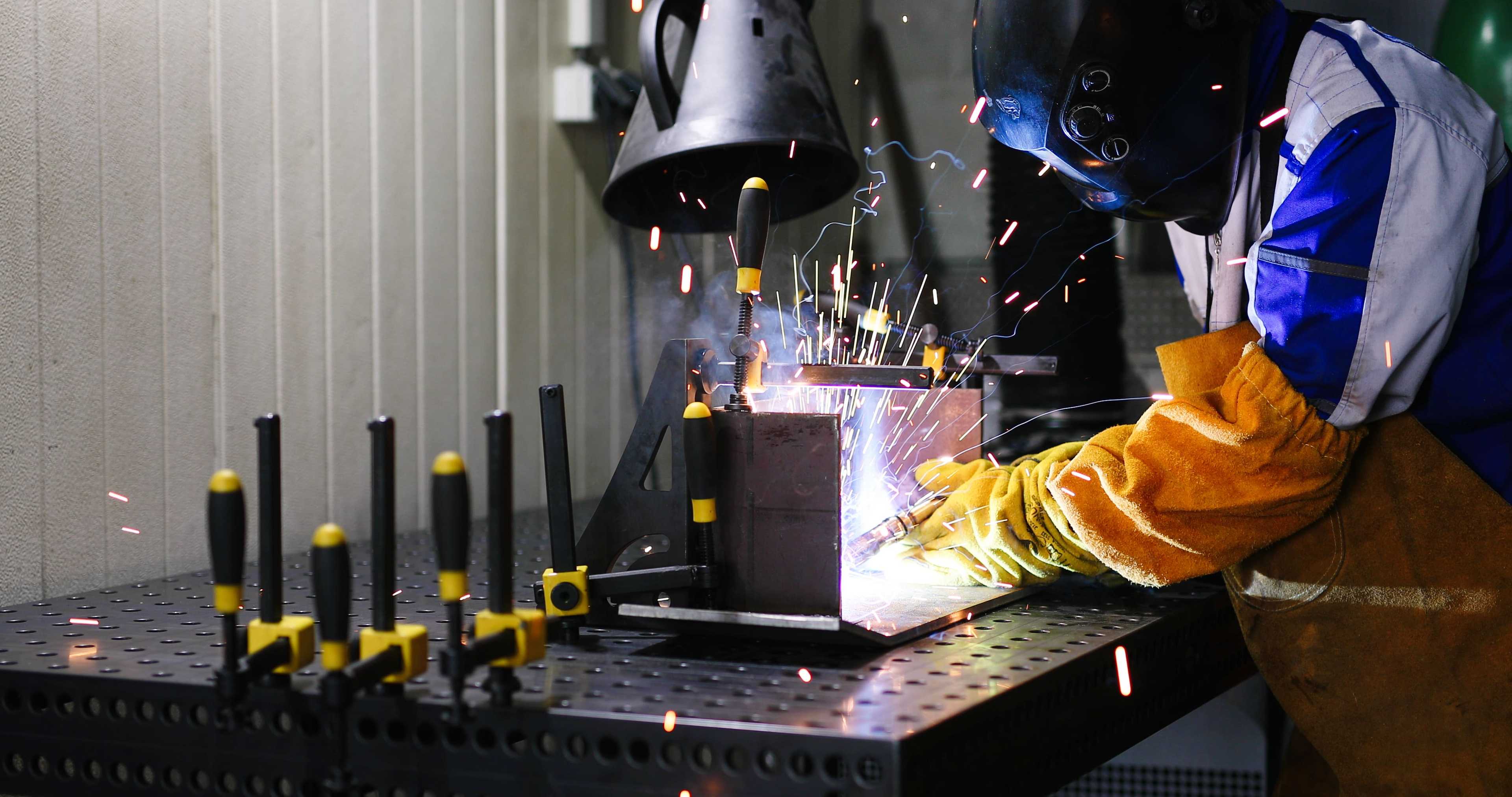Welding is a fabrication process where two or more parts are fused together. Welding is commonly used across a range of sectors including the construction, automotive and shipbuilding industries, amongst others.
Welding involves different risks depending on the materials and metal being welded, the gases or fluxes that may be emitted, the type of welding, etc. Fumes are a common occupational hazard associated with welding. There are different types of welding, such as, electric arc, TIG, MIG-MAG welding, plasma and oxy-fuel (oxyacetylene) welding, etc.
:quality(60)/1f8f22d9-b715-495a-8156-62cf561d84d8/f6e22f61-f609-4e80-bf17-ac232d892933.jpg)
Welding: occupational hazards
Health risks
Welding causes chemical pollutants such as welding fumes or metal fumes that can cause respiratory and digestive disorders, etc. Further on in this article, we will tell you what welding fumes are and the associated health problems. Other physical agents can be:
- Heat or cold: from doing welding work outdoors or from the use of tools such as welding torches.
- Noise: from the use of welding equipment or ventilation and extraction systems.
- Radiation: e.g. ultraviolet radiation from electric arc welding or infrared radiation from oxy-fuel welding.
:quality(60)/1f8f22d9-b715-495a-8156-62cf561d84d8/95ddc5c9-9987-471a-8668-51949a7ee598.jpg)
Safety risks
Cuts, impacts, burns, electric shocks or burns caused by welding equipment. The workplace in itself can also lead to accidents due to unsafe working conditions. For example, slips, trips and falls.
Ergonomic risks
Physical and visual strain, repetitive movements or forced postures can lead to fatigue, discomfort or musculoskeletal disorders, among others.
Psychosocial risks
Factors such as working conditions or inadequate planning can lead to dissatisfaction, mental fatigue or stress.
:quality(60)/1f8f22d9-b715-495a-8156-62cf561d84d8/051bf989-f9c6-494f-bc07-efecafe4d5f5.jpg)
Types of Welding PPE
The list of personal protective equipment (PPE) below is for general welding activities. A risk assessment by an expert is essential for all welding processes.
Eye and face protection for welding
- Welding goggles are available with lenses of specific shades depending on the welding work to be carried out.
- Welding helmets and masks are adapted to the shade required for welding to protect against ultraviolet and infrared radiation. They must be compatible with the respiratory protection used.
Eye and face protection also prevents users from the flying particles.
:quality(60)/1f8f22d9-b715-495a-8156-62cf561d84d8/532d8475-2fb2-45f0-bec9-be464513992c.jpg)
Respiratory Protection
Respiratory protection may be necessary for welding fumes (gases and/or particles). The type of respiratory protection will depend on the type of contaminating material, the working environment and the type of welding.
Respiratory protection can range from disposable masks that protect against practices, to combined filters that protect against both gases and particles, these include A, B, E and P filters:
- Type A: brown - protects against gases and organic vapours.
- Type B: grey - protects against inorganic gases and vapours.
- Type E: yellow - protects against sulphur dioxide and other acid gases.
- Type P: white - protects against particles.
:quality(60)/1f8f22d9-b715-495a-8156-62cf561d84d8/3fd56456-3516-4862-b61e-def3da3fb57c.jpg)
What are welding fumes?
Welding fumes contain gases and particles. The particles vary in size and can be as big as a grain of sand or so small they are inhalable and invisible to the naked eye. These welding fumes should not reach the respiratory tract and if they do, they should be diluted by ventilation systems.
In the short term, welding fumes can cause problems such as irritation of the eyes, nose and throat, dizziness, nausea, headaches and metal fume fever, among others. Metal fume fever causes high temperatures, chills, aches, pains, vomiting, weakness and tiredness. It’s more likely to occur on Mondays, after several days without exposure to welding fumes.
In the long term, welding fumes are linked to lung problems such as asthma, chronic obstructive pulmonary disease (COPD) or lung cancer. Other complications can include laryngeal cancer, urinary tract cancer, stomach ulcers, kidney damage and nervous system damage. Welding fumes also lead to an increased likelihood of heart attacks and strokes.
:quality(60)/1f8f22d9-b715-495a-8156-62cf561d84d8/c5766b61-d782-439f-83b2-73fd09ce7e23.jpg)
Welding gloves
Welding gloves are designed for heat protection, they are usually made of split leather and para-aramid fibres. Kevlar thread is a type of para-aramid and is often used in seams for heat protection. Welding gloves can protect up to 350°C, depending on the thickness of the para-aramid. In addition to being heat-resistant, para-aramid is also cut-resistant.
Meta-aramids are another type of flame-retardant fibre that provides a good air barrier by separating the fibre from the heat source. This provides additional protection, although para-aramid offers superior resistance to cuts.
:quality(60)/1f8f22d9-b715-495a-8156-62cf561d84d8/c583066e-b6e2-475c-9ff5-bccf16061459.jpg)
Protective clothing for welding
In welding, flame-retardant work clothing that is resistant to fire, sparks and high-temperature particles is recommended. Flame-retardant shirts, flame-retardant trousers or complete flame-retardant overalls may be necessary.
Other types include welding sleeves which protect up to the shoulder, welding aprons that protect the torso of the body, gaiters for the legs and welding hoods for the head and shoulders. Materials such as split cowhide leather and para-aramid stitching are commonly used in both clothing and gloves designed for welding.
:quality(60)/1f8f22d9-b715-495a-8156-62cf561d84d8/8b80d6a4-4cc1-4a5e-9758-6e154bf412e3.jpg)
Welding safety boots
Welding safety footwear is generally antistatic, metal-free and breathable with Velcro fasteners that allow the footwear to be removed quickly in the event of an accident.
Welding safety footwear is equipped with a reinforced toecap and has a high resistance to impact, heat, abrasion and corrosion. Non-slip soles that are resistant to extreme temperatures and fuel/oils are recommended, especially in industries like oil and gas, maintenance, factories and refineries, etc.
If welding is carried out at height, you need to yourself from falls at a different level by using an appropriate safety harness.
Safeguru | Delivering a Safer Future
